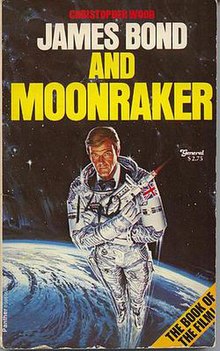|
James Bond and Moonraker
James Bond and Moonraker is a novelization by Christopher Wood of the James Bond film Moonraker. Its name was changed to avoid confusion with Fleming's novel. It was released in 1979.[1] PlotBritish Secret Service agent James Bond, codename 007, must prevent Sir Hugo Drax's plan to murder the entire human race and then restart humanity from outer space. BackgroundThe screenplay of Moonraker differed so much from Ian Fleming's novel that Eon Productions authorised the film's screenwriter, Christopher Wood to write a novelization based upon the film, as he had done for The Spy Who Loved Me. As with the first novelization, Wood had no input from, or communication with Glidrose Publications. Instead he worked directly with Jonathan Cape publisher Tom Maschler.[2] Unlike Wood's first novelization, which showed a significant difference from the actual film, in James Bond and Moonraker, Wood writes a virtually direct novelization of the screenplay.[1] The only noticeable differences between the novelization and the screenplay for Moonraker is that there is no mention of Dolly, Jaws' girlfriend, and his characterisation stays true to Wood's description as being a mute. In addition, at the conclusion of the Venetian canal chase sequence, Bond's gondola does not sprout a flotation device and ascend to St. Mark's square as it does in the film. ReceptionWood's second novelization was barely reviewed. Syndicated columnist Bob Greene was scathing. He said the novelization was "dreary and schlocky and juvenile; it lacks all of the wonderful tension and personality of the original Fleming book. James Bond would be embarrassed to be in it. [...] In the meantime, shed a tear for Ian Fleming and James Bond. And don't, under any circumstances, buy the "Moonraker" you see in the stores today. Hold out for the real thing. If you can't find it in the attic, come over and I'll lend you mine."[3] The Los Angeles Times critic claimed that Ian Fleming "would have cringed at the writing to be found in this book."[4] Despite this, Wood's novel became a bestseller,[5] remaining on The Times bestseller list for some time.[6] After the book's release, Eon Productions did not commission another Bond film novelization until Licence to Kill ten years later in 1989. Publication history
References
|
||||||||||||||||||||
